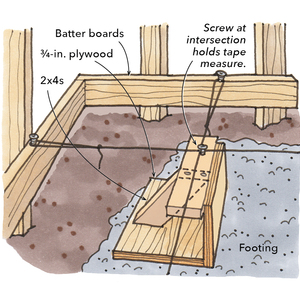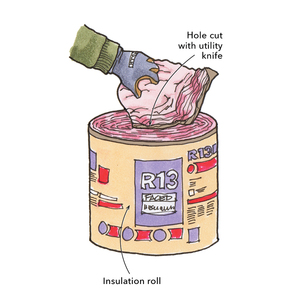One of my customers recently got a new toilet. It was installed by a professional plumber. Subsequently, I removed the toilet to put in a new floor. Before I put the toilet back, I looked underneath and found gobs of plaster (probably plaster of paris) around the horn. There was so much of it that it interfered with the wax ring and prevented the toilet from sitting flat on the new floor. I removed all of the plaster with a chisel without actually cracking the toilet and set it back in place the “right” way.
My first take on the use of plaster is that it’s a hack. Sure it will work once, but you can never remove and re-set the toilet without removing the plaster. And there’s a risk of cracking the toilet when removing the plaster.
Is my take on this right? Is it a hack? Or is this established procedure?
-Don



















Replies
Ceramic pieces do not normally plane true, so they will rock and roll a bit. This is because of the way they shrink and warp slightly in the fireing.
Add to that, the fact that the old floor could have been gobbled up unevenly.
It is an acceptable process to use the plaster to seat the toilet, just as it is to use a bag of mortar to set a bathtub, for solidity. I applaude him for doing it, taking the time and all, but if it interferred with the wax ring seal, he might have been a little careless in the way he did it is all. but then, it is kind of hard to stand on your head to see how it's going as you lower the bowl onto the hole.
;)
Welcome to the
Taunton University of Knowledge FHB Campus at Breaktime.
where ...
Excellence is its own reward!
I retiled a floor in 1970 house. The HO was going to demo the old mud set floor and cracked the toilet. Which is good because I would have problem done that when I tried to pull it.Anyway not only was it set in a paster like material it was also used for the seal between the horn and flange.
I agree with that sex maniac Piffin. I've used plaster at times myself when the bowl didn't sit right just like with some tubs.
Actually what I use is Structolite and I "always" lay a thin sheet of plastic over it first so it doesn't actually stick to the bowl or the tub bottom and the plastic is loose and thin enough that it still forms to the bottom of the fixtures.
Same plastic you see on clothes from the dry cleaners.
I have dreamt of an open world, borderless and wide... where the people move from place to place, and nobody's taking sides.. http://www.yusufislam.com
http://WWW.CLIFFORDRENOVATIONS.COM
i see another use for WD40 here.... use it vs the plastic sheet... spray the bottom of the bowl... pretty sure even 20yrs later it would still release
p
good idea. And you know none of the manufacturers would suggest any of these ideas. they'd rather see us break the fixtures out so we'd have to buy another.
I have dreamt of an open world, borderless and wide... where the people move from place to place, and nobody's taking sides.. http://www.yusufislam.com
http://WWW.CLIFFORDRENOVATIONS.COM
That is the only way a toilet should be set in my opinion. The bottom of the toilet is rarely true, it is normally set on a tile floor that is rarely true, most plumberers use shims of some sort to keep the bowl from rocking, a plaster base makes it a solid install.
"[plaster]is the only way a toilet should be set in my opinion."How do you go about doing that? Do you trowel plaster onto the outer edges and then wipe away the excess? How do you level it?I have been dry fitting the toilet and leveling it with shims, then lifting it off, setting the wax ring and lowering back in place. Finally I cut the shims and caulk with "grout-in-a-tube".
BruceT
I set the toilet dry, trace the outline on the floor, lift it back up, set the wax ring, then mix up and place the plaster along the oulline on the floor. Then I set the toilet in the wet plaster, clean up the ooze out with a wet sponge. 15 minutes of drying time, and that hopper don't rock.
I like your technique. Not only does it make for a stable toilet, but it's also relatively easy to clean up if the bowl ever needs re-setting.
If that's what I had seen, I wouldn't have started this thread. I would probably have thought, "now, that's clever". What I did see was way too much plaster, plaster interfering with the wax ring and plaster centered under the bowl (not around the perimeter).
Thanks to everyone for your input. I hadn't seen this technique before and I jumped to conclusions about it being a "hack". Instead, what I saw was a good idea that wasn't well executed.
-Don
ya fergot to tell him about putting saran warp. wax paper, 2 mil plastic or whaterver is handy on / over the plaster as a bond breaker before you set the toilet....
Life is not a journey to the grave with the intention of arriving safely in a pretty and well preserved body, but rather to skid in broadside, thoroughly used up, totally worn out, and loudly proclaiming<!----><!----><!---->
WOW!!! What a Ride!<!----><!---->
Forget the primal scream, just ROAR!!!
We always set out toilets with grout left over from the floor if it was a tile floor. A little rub of wax from the ring if you are worried about sticking. put grout around the perimeter, set the base and then sit on it, that usually does the trick. Then clean up the grout squeeze out and onward thru the fog....
How do you keep from having saran wrap sticking out when you get done?
BruceT
razor knief...
Life is not a journey to the grave with the intention of arriving safely in a pretty and well preserved body, but rather to skid in broadside, thoroughly used up, totally worn out, and loudly proclaiming<!----><!----><!---->
WOW!!! What a Ride!<!----><!---->
Forget the primal scream, just ROAR!!!
bwst plastic I've found sre the plastic shopping bags...
Life is not a journey to the grave with the intention of arriving safely in a pretty and well preserved body, but rather to skid in broadside, thoroughly used up, totally worn out, and loudly proclaiming<!----><!----><!---->
WOW!!! What a Ride!<!----><!---->
Forget the primal scream, just ROAR!!!
You're actually looking at something that does qualify as Fine Home Building.
Slopping it into the ring, probably not.
Joe H
Plaster & shims is common depending on the plumber.
My commercial jobs we use sheet lead, but only if it's a small wobble.
Big wobbles we usually either trash the toilet or take it back for another one.
To replace it with one that does not wobble is not a big deal for us, cause on larger jobs we usually will be setting a 100 plus of them so deliveries are weekly.
“It so happens that everything that is stupid is not unconstitutional.” —Supreme Court Justice Antonin Scalia